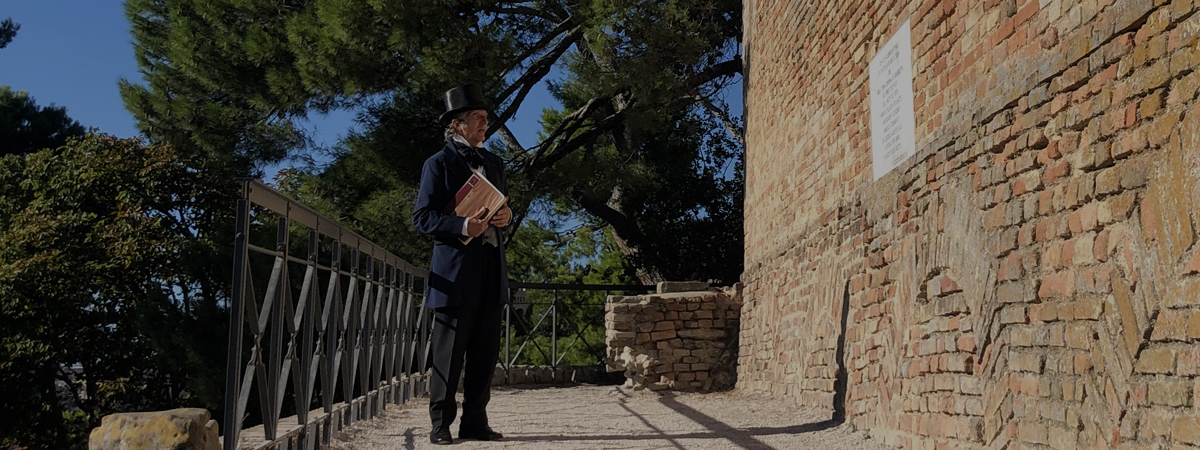Lorenzo Lotto in Recanati
Rrecanatis' works
THE GREAT SAINT JAMES
CARTA D’IDENTITÀ
Saint James the Great
1512-1513 approximately
Oil on panel
Provenance: Recanati, oratory of San Giacomo, sacristy; Recanati, church of S. Maria sopra Mercanti (from around 1770); Recanati municipal art gallery (since 1953); Recanati Villa Colloredo Mels (since 1998)
Restoration: 1981
Ownership: IRCER Foundation, Recanati; in storage at Villa Colloredo Mels
The painting depicts San Giacomo Maggiore/Saint James the Great, one of the twelve apostles with his brother John, while he is walking.
In his right hand, he holds a cane covered in a white handkerchief knotted on a hook, with the function of a prayer counter. With his left arm, he holds the open volume of the Holy Scriptures to indicate the mission of his preaching. On the ground, there is a hat – where you can recognize the shell of Saint James, the most widespread symbol of the pilgrimage and the face of Christ, the water bottle and the sack with supplies. In the background there is the sea and a harbor, recognized by some as that of Recanati (today Porto Recanati) or Ancona; others have identified the architectural complex as that of the Basilica of the Holy House of Loreto.
The work was carried out after the artist’s stay in Rome: connections with Raphael’s style and palette are evident in the brilliant chromatic texture and the delicate treatment of the facial features; there are also similarities with contemporary works such as the Transfiguration (visible in this museum) and the Deposition of Jesi (1512).
THE WORK
CHRONOLOGICAL FRAMEWORK
1510
Teseo de Cuppis, bishop of Recanati from 1507 to 1516, consecrated the Oratory of San Giacomo in Recanati. the bishop was in contact with Lorenzo Lotto at that time, in fact the artist may have received the commission for the work on this occasion, as he stayed in the city twice in the same year. In this period Lotto also painted the fresco depicting San Vincenzo Ferrer in glory (around 1510-1511), for the church of S. Domenico and the Transfiguration (around 1510-1512), for the church of S. Maria di Castelnuovo.
1510, April 14
Lorenzo Lotto is present in Recanati as witness of a deed drawn up by the notary Antonio Angelelli for a sale made by the Venetian merchant Agostino de Sinistri, one of the most active at the Recanati fair.
1510, August 10
Lorenzo Cipriani from Recanati paid 80 ducats in several installments directly to Lorenzo Lotto for having executed the Polyptych of San Domenico (1508).
1620, March 8
The archconfraternity of the Nobles may be the owner of the painting, as mentioned in the Oratory of San Giacomo: “a painting of San Giacomo made by Lotto which has today been returned to the Fraternity. It has been lost for a long time…The priors who will be for the time to come at the beginning of their office, should pass it on to the hands of the others who will succeed”. It is clear from the text that the work had been missing for an indefinite time.
1711
Diego Calcagni described this work in his historical memoirs of the city of Recanati as a tablet, which in the past was carried by the Deputies of the Company, when they went begging. Lorenzo Lotto reproduces St. James with Bordone in an extraordinary way.
1770
The painting was transferred to the church of S. Maria sopra Mercanti in Recanati.
1894
Pietro Gianuizzi states the work as one of the many made by Lorenzo Lotto in the Marche and Recanati, bringing to the attention of scholars the transcription of the 1620 document reported above.
1953
After being exhibited at the Lorenzo Lotto exhibition curated by Pietro Zampetti at the Doge’s Palace in Venice (14 June – 18 October 1953), the work was transferred in the art gallery of Recanati, remaining property of the IRCER Foundation of the city, an organization which still exists.
1998
The painting becomes part of the exhibition itinerary of the Civic Museums of Villa Colloredo Mels.
Saint James the Greater. The subject
The work depicts St. James the Greater who, with his brother John, author of one of the Gospels, was part of the twelve apostles. It is said that upon Jesus’ death he reached Galicia, Spain to spread the Gospel. Upon his return to Jerusalem he was killed, around 42 A.D. as recorded in the Acts of the Apostles: At that time King Herod (Agrippa I) began to persecute some members of the Church. He had James, John’s brother, killed by the sword” (Acts of the Apostles, 12:2). He thus became the first martyred apostle. His body is preserved in Santiago de Compostela in Spain, in the shrine destination of the well-known Way of St. James.
St. James the Greater witnessed many pivotal events in the history of Christianity, such as the Transfiguration on Mount Tabor, a subject painted by Lorenzo Lotto for the church of S. Maria di Castelnuovo di Recanati and visible in this same museum.
St. James the Greater is depicted as a mature man, with beard and dark hair parted in the middle and spiked at the sides like Christ’s; his face appears sad and fatigued; he is walking on the stony path and his gaze is turned not toward the viewer but in the direction of the bright landscape behind him. The saint with his right hand clutches his staff characterized by a white handkerchief with a prayer-counting function knotted to a hook; with his left arm he clutches the open volume of the Holy Scriptures to indicate the mission of his preaching; on the ground are depicted the hat-where the shell of St. James, the most widespread symbol of pilgrimage, and the face of Christ are recognizable-the water bottle and the sack with provisions.
Saint James the Greater. Historical critical reading
The small painting was probably commissioned after 1510, the year of consecration, by the bishop of Recanati Teseo de Cuppis, of the new Oratory of San Giacomo as a place of prayer of the Confraternity (or Congregation) of the Recanati Nobles. The façade of the building is still visible adjacent to the Vanvitellian church of San Vito and the former Jesuit College, now home to an educational institute.
The work depicts Saint James the Greater who, with his brother John, author of one of the Gospels, was part of the twelve apostles. It is said that upon Jesus’ death he reached Galicia, Spain to spread the Gospel. Upon his return to Jerusalem he was killed, around 42 AD. C. as we read in the Acts of the Apostles: at that time king Herod (Agrippa I) began to persecute some members of the Church. He had James, brother of John, killed by the sword (Acts of the Apostles, 12.2). He thus became the first martyr apostle. His body is buried in Santiago de Compostela in Spain, in the sanctuary destination of the well-known Camino de Santiago.
San Giacomo Maggiore witnessed numerous key events in the history of Christianity, such as the Transfiguration on Mount Tabor, a subject painted by Lorenzo Lotto for the church of S. Maria di Castelnuovo di Recanati and visible in this same museum.
The painting shows the solitary and imposing figure of the pilgrim saint, placed on a hill; in the background, there is a blue sky crossed by soft white clouds. Below, you can see a harbor dominated by a fortified place and characterized by a large architectural complex. Some scholars recognized the port of Recanati at the mouth of the Potenza river (at the time it was a landing place), others that of Ancona but also the basilica complex of nearby Loreto, whose walls were under construction in this period.
Saint James the Great is depicted as a mature man, with a beard and dark and middle part hair parted like Jesus Christ. His face looks sad and tired; he is walking on a stony path and his look isn’t directed towards the viewer but towards the bright landscape behind him. The saint holds a cane with a white handkerchief knotted to a hook, as symbol of a prayer counter; with his left arm he holds the open volume of the Holy Scriptures to indicate the mission of his preaching. On the ground there is a hat – where you can recognize the shell of Saint James, the most widespread symbol of the pilgrimage and the face of Christ – a water bottle and a sack with supplies.
Most critics date the painting between 1512 and 1513 due to its stylistic affinities with works by Raphael such as the Madonna of Foligno and with those painted by Lotto in the same years such as the Deposition of Jesi (1), the Transfiguration of Recanati (in particular the predella, 2) and the little Judith with the head of Holofernes (3). Others place the work in the early years of Bergamo, between 1515 and 1517, due to its formal proximity to works such as the monumental Martinengo Altarpiece (1513-1516, Bergamo, church of SS Stefano and Bartolomeo, 4).
A painting mention from 1620 in the Oratory of San Giacomo, describe it as property of the Archconfraternity of the Nobles. “…painting of San Giacomo made by Lotto which has today been returned to the Fraternity…which has been lost for a long time ….The priors who will be in future times in their office will pass it on to the ones who will succeed them”.
From the text, it is clear that the work had been lost for an undefined time and that a significant value was attributed to it in the context of the confraternity’s heritage, so much to dictate the adoption of particular measures to protect its conservation.
Also mentioned by the local historian Diego Calcagni in his historical memoirs of the city of Recanati published in 1711, in 1770 it was transferred to the church of S. Maria sopra Mercanti in Recanati.
The Great Saint James was included among Lorenzo Lotto’s corpus of works in 1894 by Pietro Gianuizzi who also specified that it was kept under glass within a vague and original carved and gilded frame.
DETAILS
The landscape
The painting is dominated by the solitary and imposing figure of the pilgrim saint, placed above a rise; in the background, a blue sky furrowed by fluffy white clouds opens at the top; below is a port overlooked by a fortified place and connoted by a large architectural complex. Some scholars have wanted to recognize there the port of Recanati at the mouth of the Potenza River (it was a landing place at the time), others that of Ancona, but also the basilica complex of nearby Loreto, whose walls were under construction at this time.

